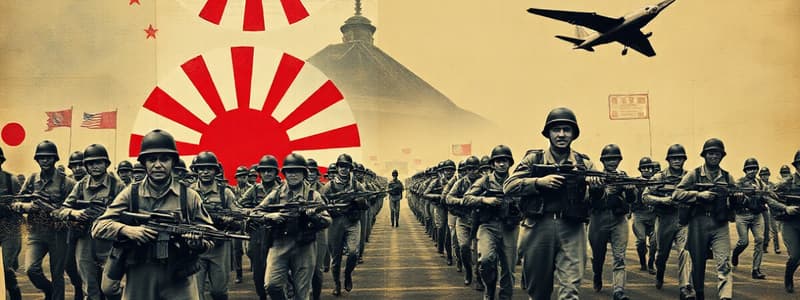Podcast
Questions and Answers
Which method did the Japanese NOT use to control the local population during their occupation?
Which method did the Japanese NOT use to control the local population during their occupation?
- Public executions to instill fear
- Establishing free market trade regulations (correct)
- Use of coercive financial measures against the Chinese business community
- Imprisonment and torture of suspected disloyalty
What was a significant consequence of the severe food shortages during the Japanese occupation?
What was a significant consequence of the severe food shortages during the Japanese occupation?
- Improvement in public health policies
- Rise of a black market with inflated prices (correct)
- Increase in agricultural productivity
- Formation of cooperative farming initiatives
Which propaganda message did the Japanese promote to gain local support?
Which propaganda message did the Japanese promote to gain local support?
- Western colonial rule should be eradicated
- Japanese imperialism is harmful to local cultures
- Traditional practices should be preserved
- They were liberators bringing modernization (correct)
What was one of the outcomes of the collaboration between local Malays and Japanese forces?
What was one of the outcomes of the collaboration between local Malays and Japanese forces?
What major event led to Japan’s surrender at the end of World War II?
What major event led to Japan’s surrender at the end of World War II?
Flashcards are hidden until you start studying
Study Notes
Methods of Japanese Control
- The Japanese used fear and force to control the population, employing harsh punishments such as public executions and the Kempeitai (Japanese military police).
- Allied soldiers and locals suspected of disloyalty were frequently imprisoned and subjected to torture.
- Targeting the Chinese business community through financial pressure was a strategy aimed at crippling their perceived support for anti-Japanese activities.
Winning Loyalty
- Japanese propaganda promoted their image as liberators from Western colonial rule and presented their vision of a Greater East Asia Co-prosperity Sphere.
- Japanese language and cultural practices were emphasized in schools, and citizens were encouraged to adopt Japanese traditions to foster loyalty.
Living Conditions
- Severe food shortages due to rationing led to a thriving black market where goods were sold at exorbitant prices.
- Rampant inflation, caused by the overprinting of money, made basic goods unaffordable for most citizens.
Responses to Japanese Rule
- Some Malays collaborated with the Japanese, participating in local governance and policing efforts, and were rewarded for reporting suspected anti-Japanese activities.
- Resistance groups, like the Malayan People's Anti-Japanese Army (MPAJA) and Force 136, engaged in guerrilla tactics and intelligence operations to weaken Japanese authority.
Conclusion of the Occupation
- The atomic bombings of Hiroshima and Nagasaki in August 1945 led to Japan's surrender on August 15, 1945.
- Following liberation, the MPAJA sought retribution against collaborators while the British returned to restore order and initiate reconstruction efforts.
Studying That Suits You
Use AI to generate personalized quizzes and flashcards to suit your learning preferences.




